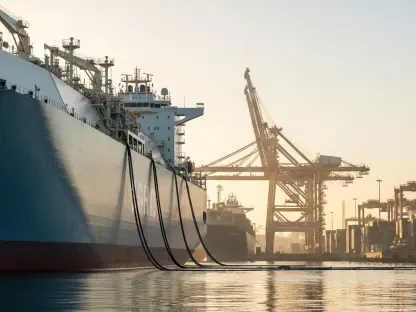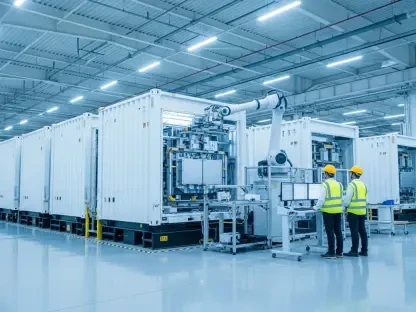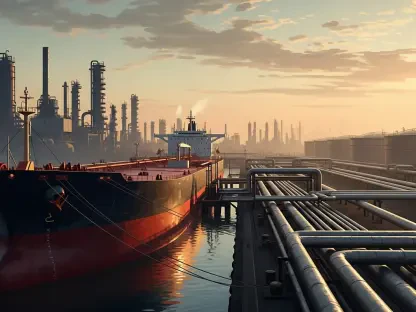The maritime industry faces an imperative shift toward sustainable energy to comply with stringent global regulations on greenhouse gas (GHG) emissions. In light of this, a comprehensive study led by ABS, in collaboration with CE Delft and Arcsilea, focuses on evaluating hydrogen and wind-assisted propulsion systems as frontrunners for cleaner marine fuel alternatives. Presented at the 2024 SMM conference in Hamburg, this research sheds light on the multifaceted benefits, challenges, and potential of these emerging technologies.
Comprehensive Analysis of Hydrogen as Marine Fuel
The Potential of Hydrogen
Hydrogen has been spotlighted as a revolutionary fuel capable of significantly lowering maritime GHG emissions. Central to this discussion is its ability to produce zero emissions when used in fuel cells. Additionally, hydrogen’s high energy density makes it an attractive alternative to traditional fossil fuels. However, realizing its full potential necessitates addressing critical challenges related to production, storage, and distribution.
Using hydrogen as a marine fuel could drastically cut down emissions from maritime operations, positioning it as a linchpin in the effort to decarbonize the industry. The fuel cells convert hydrogen into electricity with water vapor as the only byproduct, eliminating carbon dioxide and other harmful pollutants. Moreover, hydrogen boasts an impressive energy-to-weight ratio, enabling ships to travel longer distances without the substantial fuel weight burden that traditional fossil fuels impose. Yet, transitioning to hydrogen demands overcoming substantial hurdles, primarily revolving around its production and storage.
Production and Storage Challenges
Producing hydrogen, particularly green hydrogen derived from renewable energy sources, is currently a key bottleneck. The high costs and energy requirements for electrolysis, which splits water into hydrogen and oxygen, complicate its widespread adoption. Storage presents another hurdle, as hydrogen’s low liquefaction temperature and high flammability demand robust safety measures and advanced containment solutions.
The production method for hydrogen significantly influences its environmental and economic viability. Green hydrogen, generated via renewable energy-powered electrolysis, is ideal due to its low environmental impact. However, this process is energy-intensive and costly, deterring its large-scale adoption. Many current hydrogen production methods still rely on fossil fuels, thus negating some environmental benefits. Additionally, hydrogen’s storage challenge is non-trivial. Liquefying hydrogen requires extremely low temperatures, which necessitates sophisticated and expensive infrastructure. Its flammability raises safety concerns that necessitate airtight containment systems and rigorous safety protocols.
Economic Feasibility and Infrastructure Needs
Transitioning to hydrogen requires substantial investments in infrastructure. Ports and shipping companies must develop comprehensive refueling networks to support hydrogen-powered vessels. The study emphasizes the need for public-private partnerships and financial incentives to alleviate these initial costs. Over the long term, however, the reduced environmental impact and compliance with stricter emission regulations could justify the investment.
Building the requisite infrastructure to support hydrogen as a marine fuel is a formidable task. Creating a global refueling network entails retrofitting existing ports with hydrogen storage and dispensing facilities, a venture requiring substantial capital outlay. Public-private partnerships can play a pivotal role in financing these developments, while government subsidies can help offset the initial costs of hydrogen technology adoption. Despite the high upfront costs, long-term financial models suggest that the reduced operational expenses from lower fuel costs and compliance with stricter GHG regulations will make hydrogen an economically sound choice in the future. Therefore, transitioning to hydrogen could offer a lucrative return on investment while advancing environmental goals.
Exploring Wind-Assisted Propulsion Systems
Harnessing Wind Energy
Wind-assisted propulsion offers an immediate, low-carbon solution to enhance ship efficiency. Tools like modern sails, rigid wing sails, and towing kites can tap into natural wind forces to reduce fuel consumption. These technologies are not only applicable to new builds but can also be retrofitted to existing vessels, thereby providing versatility in their deployment.
Harnessing wind energy for marine propulsion is not a novel concept, but advancements in technology have significantly enhanced its viability and efficiency. Modern wind-assisted propulsion systems, including Flettner rotors, rigid sails, and kites, are designed to supplement engine power, thereby reducing the overall fuel consumption and emissions. These innovations can be installed on a wide range of vessels, from cargo ships to tankers, offering flexibility in deployment. Retrofitting existing ships with wind-assisted systems can provide substantial emission reductions and operational cost savings without necessitating a complete overhaul or replacement of the vessel.
Technological Advancements and Applications
Recent advancements in wind-assisted propulsion technologies have made them more viable and efficient. The consortium’s research highlights successful case studies where these systems have led to significant fuel savings and emission reductions. By capitalizing on favorable wind conditions, ships can augment their propulsion while maintaining optimal operational efficiency.
Technological innovations have transformed wind-assisted propulsion from a niche solution to a mainstream option for reducing marine emissions. Real-world applications have demonstrated that modern sails and kites can slash fuel usage by up to 20%, translating into significant cost savings and lower emissions. Advances in materials and design have resulted in more durable and efficient systems that can withstand harsh marine environments. Implementing these technologies involves sophisticated software to predict optimal wind patterns and guide the utilization of wind energy for propulsion. As the technology matures, its benefits become increasingly evident, making it an attractive option for both retrofitted and newly built ships.
Cost Efficiency and Operational Benefits
While the initial setup cost for wind-assisted systems may be substantial, the operational savings are noteworthy. Reduced fuel consumption directly translates to lower operational costs and prolonged engine life, offering long-term financial benefits. Furthermore, integrating wind power can serve as a stepping stone toward full decarbonization, making it an integral part of the maritime industry’s strategy.
The economic attractiveness of wind-assisted propulsion extends beyond fuel savings. Reduced fuel consumption lowers operating costs and decreases engine wear and tear, potentially extending the engine’s lifespan and reducing maintenance expenses. While the upfront costs for installing wind-assisted systems may be high, the long-term financial benefits often justify the investment. Additionally, wind-assisted propulsion aligns with global decarbonization goals, setting the stage for future advancements in renewable marine technologies. By incorporating wind power, the maritime industry can make significant strides toward achieving emission targets while reaping economic rewards.
Regulatory and Safety Considerations
Navigating the Regulatory Landscape
Regulatory compliance is paramount for the adoption of hydrogen and wind-assisted propulsion systems in the maritime sector. International maritime organizations are progressively updating regulations to embrace these new technologies. The study calls for harmonized global standards to ensure seamless integration and interoperability.
The regulatory landscape is a formidable yet essential aspect of adopting new marine propulsion technologies. It is critical for international maritime organizations to create and harmonize regulations that facilitate the widespread adoption of hydrogen and wind-assisted systems. The study underscores the need for clear, consistent standards across the globe to ensure these technologies can be seamlessly integrated into existing frameworks. Updated regulations must address the unique characteristics of these systems while fostering innovation and safety. As regulatory bodies continue to evolve, collaboration between industry stakeholders and policymakers will be crucial to crafting effective guidelines.
Safety Protocols for Emerging Technologies
Safety remains a crucial concern, particularly for hydrogen fuel. The report underscores the importance of strict safety protocols to manage its flammability and storage complexities. As for wind-assisted systems, potential hazards include structural integrity under extreme weather conditions and navigational challenges. Regulatory bodies must address these issues to facilitate wider acceptance and implementation.
Implementing innovative propulsion technologies necessitates stringent safety protocols to mitigate associated risks. For hydrogen, safety concerns revolve around its flammability and the technical challenges of storage and handling. Robust safety measures and advanced containment solutions are essential to prevent accidents. Wind-assisted systems, while inherently safer than hydrogen, present their own set of challenges, such as ensuring structural integrity during extreme weather conditions. Navigational adjustments must be made to optimize wind energy use without compromising safety. Regulatory bodies must address these safety concerns in their standards to foster broader acceptance and implementation of these technologies in the maritime industry.
Sustainability and Scalability
Environmental Impact and Sustainability
Both hydrogen and wind-assisted propulsion systems offer a promising reduction in GHG emissions, aligning with global sustainability goals. Hydrogen usage results in zero CO2 emissions at the point of use, while wind-assisted systems significantly cut down on fossil fuel consumption. Scaling these technologies, however, calls for concerted efforts in research and development, public policy support, and industry collaboration.
Adopting hydrogen and wind-assisted propulsion systems represents a significant step toward achieving environmental sustainability in the maritime industry. Hydrogen, when used in fuel cells, emits zero CO2, making it a powerhouse for reduction in GHG emissions. Wind-assisted propulsion systems reduce reliance on fossil fuels, subsequently lowering emissions and contributing to cleaner air and water. Realizing the full environmental benefits of these technologies requires ongoing research and development to overcome existing technical limitations. Public policy support and industry collaboration are crucial to scale these solutions, ensuring they become integral components of maritime operations worldwide.
Market Scalability and Future Prospects
The maritime sector must pivot toward sustainable energy to meet stringent global regulations on greenhouse gas (GHG) emissions. Recognizing this necessity, a detailed study helmed by ABS, and in cooperation with CE Delft and Arcsilea, examines hydrogen and wind-assisted propulsion systems as leading candidates for cleaner marine fuel alternatives. The findings, unveiled at the 2024 SMM conference in Hamburg, illuminate the varied benefits, challenges, and promise of these novel technologies.
This research offers critical insights into how hydrogen, with its zero-emission potential, and wind-assisted systems, which can significantly reduce fuel consumption, could revolutionize maritime transport. By delving into operational efficiency, cost implications, and technological readiness, the study aims to provide a holistic understanding of these advancements.
The shift to sustainable energy in maritime operations is not merely an option but a mandate driven by global environmental policies. Through collaborative efforts, the industry can navigate the complexities of implementing hydrogen and wind-assisted propulsion, laying the groundwork for a greener future on the seas.









